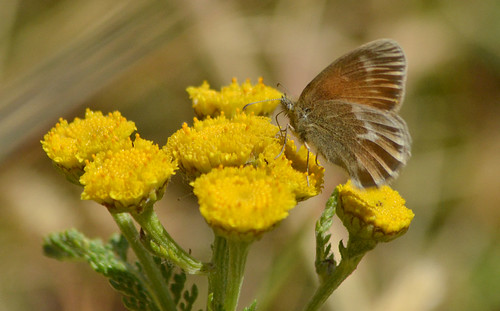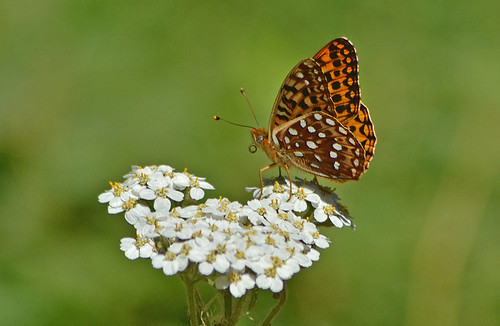It’s summertime, and summertime means butterflies.
I set out on the first day of July to see how many species I could find by targeting specific habitats. I began my day at Stanley Marsh, where I was greeted by a big female WESTERN TIGER SWALLOWTAIL nectaring on Eurasian blackberry (Rubus discolor).
The key to understanding the distribution of butterflies is to understand the distribution of the plants they depend upon. All butterflies begin as caterpillars and many caterpillars have strict dietary requirements. In our region, willows are the primary larval host plant for the tiger swallowtails, and the savvy butterfly watcher knows that the best place to find an ANISE SWALLOWTAIL is in the nearest patch of Seawatch (Angelica lucida).[wc_clear_floats]
 Willows and seawatch are most easily found in more open flood plains and dunes. There are plenty of spots along the Neawanna corridor from Thompson Creek to the Neawanna Mill Ponds for these species.
Willows and seawatch are most easily found in more open flood plains and dunes. There are plenty of spots along the Neawanna corridor from Thompson Creek to the Neawanna Mill Ponds for these species.
To find an ECHO AZURE, one must find Pacific crab-apples (Malus fusca) or Nootka rose (Rosa nutkana), and OCHRE RINGLETS prefer open, grassy meadows. My favorite spot for these species is a piece of recovering coastal prairie called Pinehurst at the north end of the Neacoxie Forest.
 The availability of proper host plants for the youngsters is not enough, however. Adult butterflies need a dependable source of nectar producing flowers to feed on, so the best butterfly spots have a combination of larval host plants and flowers that are in bloom and producing nectar when the adults are flying. Remnant coastal prairies, lightly managed to control invasive Scotch broom and blackberries, provide space for many of these important native wildflowers.
The availability of proper host plants for the youngsters is not enough, however. Adult butterflies need a dependable source of nectar producing flowers to feed on, so the best butterfly spots have a combination of larval host plants and flowers that are in bloom and producing nectar when the adults are flying. Remnant coastal prairies, lightly managed to control invasive Scotch broom and blackberries, provide space for many of these important native wildflowers.
 Butterflies are not the only beneficiaries in these places. Among the butterflies, bees and other insect species are what Robert Michael Pyle refers to in The Butterflies of Cascadia (2002) as “honorary butterflies.”
Butterflies are not the only beneficiaries in these places. Among the butterflies, bees and other insect species are what Robert Michael Pyle refers to in The Butterflies of Cascadia (2002) as “honorary butterflies.”
 Many moth species are nocturnal, but there are quite a few that are out during the day. Moths are very closely related to butterflies. Just like butterflies they require species specific larval host plants and good nectaring sources for the adults, and a few of them play an important role in controlling invasive plant species.
Many moth species are nocturnal, but there are quite a few that are out during the day. Moths are very closely related to butterflies. Just like butterflies they require species specific larval host plants and good nectaring sources for the adults, and a few of them play an important role in controlling invasive plant species.
 I was able to find 13 species of butterflies and five species of day-flying moths on my day of bug chasing, most of them on properties managed by North Coast Land Conservancy. Fifty-four species of butterflies have been recorded in or around our North Coast region. I probably could have found more, if I had been willing to drive around the county like a crazy person, but 25 percent of the butterfly list certainly isn’t bad. This is especially true because some of the species on that list of 54 have not been seen in more than 40 years and may represent butterflies that no longer occur in the area. We know of at least one that was once common on the coastal prairies and can no longer be found, the Oregon silverspot butterfly.
I was able to find 13 species of butterflies and five species of day-flying moths on my day of bug chasing, most of them on properties managed by North Coast Land Conservancy. Fifty-four species of butterflies have been recorded in or around our North Coast region. I probably could have found more, if I had been willing to drive around the county like a crazy person, but 25 percent of the butterfly list certainly isn’t bad. This is especially true because some of the species on that list of 54 have not been seen in more than 40 years and may represent butterflies that no longer occur in the area. We know of at least one that was once common on the coastal prairies and can no longer be found, the Oregon silverspot butterfly.
 Continuing efforts to reclaim and restore coastal prairie systems will in time (we hope) lead to a day when this threatened species can once again be counted on a summer’s day of butterfly chasing.
Continuing efforts to reclaim and restore coastal prairie systems will in time (we hope) lead to a day when this threatened species can once again be counted on a summer’s day of butterfly chasing.
—Mike Patterson
Join naturalist Mike Patterson on an On the Land outing August 25 or September 19. You can follow more of his adventures and observations at North Coast Diaries.
Comments